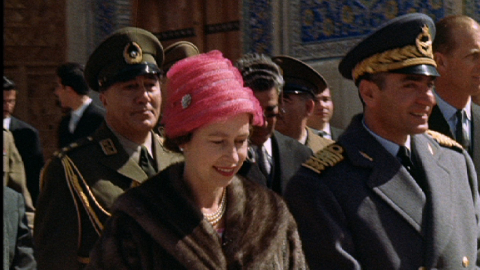This film is part of Free

The Queen's State Visit to Iran
2-6 March 1961 saw the Queen and Prince Philip make their first and only state visit to Iran. Their host was Mohammed Reza Pahlavi (1919-80), the Shah of Iran, who had already made an official visit to Britain in 1959.
Overview
While the commentary regularly stresses the close historical links between the two countries, it unsurprisingly doesn’t mention Britain’s extensive (albeit undercover) involvement in the coup d’état of 1953 that saw the overthrow of Iran’s nationalist Prime Minister Mohammed Mosaddegh and the Shah’s elevation from constitutional to absolute monarch. He was understandably grateful to Britain, but many Iranians were considerably less so, and after the Islamic revolution of 1979, the UK would be widely regarded as ‘the little Satan’ (with the US as its bigger brother), with diplomatic relations rarely better than poor, frequently abysmal, and sometimes formally non-existent.
As a result, this film has inescapably become a fascinating time capsule. The commentary is at pains to give the Shah his full imperial title (‘Shahanshah’, literally ‘King of Kings’), and the Shah himself is equally keen to emphasise pomp and ceremony, state coaches and crown jewels. The Queen visits organisations with a strong British connection (the Church of England Missionary Society, the Princess Ashraf School of Nursing), though it’s Prince Philip’s tour of the CENTO Institute of Nuclear Science at Tehran University that is most eye-catching given that Iran’s nuclear ambitions have rarely been out of 21st century headlines. The Shah was keen on developing civilian nuclear energy in order to place less domestic reliance on oil (already a valuable export in 1961, even more so after the 1973 price shock), and Iran was one of the first beneficiaries of President Eisenhower’s Atoms for Peace programme, which provided technical assistance in exchange for sharing research about nuclear power’s peaceful benefits. The royal party is also given guided tours of Tehran, Isfahan, Shiraz and the ruins of Persepolis, with much stress laid on Iran’s longevity as a civilisation, and the magnificence of its ancient architecture. Sights include the Golestan (or Rose Garden) Palace, the tomb of Reza Shah the Great (the Shah’s father), the sixteenth-century mosques of Sheikh Lotf Allah and Shah Abbas, the Ali Qapu (or Lofty Gateway), and a large-scale sports display at the Amjadieh stadium (now the Shahid Shiroudi stadium) involving dancing, traditional Iranian exercises and an impressively synchronised display of calisthenics.
Related

London Line Colour No. 16 London Line Colour No. 16
Cinemagazine 1968 14 mins Silent Location: Surbiton
What do "I'm Backing Britain", electronic music and nuclear lighthouses have in common? Nothing at all, but they're all here in this 60s TV magazine show.

Nurse and Martyr Nurse and Martyr
Biopic 1915 11 mins Silent
The moving true story of wartime heroine Nurse Edith Cavell, recreated in the aftermath of her execution.

Spare Time Spare Time
Documentary 1939 14 mins Location: Sheffield
A rare glimpse into the leisure pursuits of ordinary people in pre-war Britain.

Listen to Britain Listen to Britain
Documentary 1942 20 mins
Humphrey Jennings and Stewart McAllister's masterly collage of the various people and classes of Britain - at home and at work, at war and at peace - is one of the great films of war-time Britain.

Battle Front in Britain Battle Front in Britain
Documentary 1918 24 mins Silent
Growing potatoes in Green Park plus some handy uses for your old tin cans – it’s all part of the war effort on the home front.

Zandra Rhodes Zandra Rhodes
Government sponsored film 1981 15 mins
Early 1980s portrait of fashion designer Zandra Rhodes, by fellow avant-garde creator, Peter Greenaway.

China O'Brien: The Reunion China O'Brien: The Reunion
Documentary 2024 60 mins
Cynthia Rothrock, Richard Norton and Keith Cooke reunite three decades on from the groundbreaking martial arts classic.

Women in Action Panel Discussion Women in Action Panel Discussion
Inside Film 2024 28 mins
Action Xtreme - the UK's leading action film studio - hosts this panel discussion with four leading women in action cinema - Soo Cole, Jo Rolison, Jadey Duffield and Ioanna Karavela.

Starve Acre - Exclusive Q&A Starve Acre - Exclusive Q&A
Short interview 2024 24 mins
Daniel Kokotajlo talks to Nia Childs about Starve Acre, his folk horror about a couple digging deep into grief in the heart of the Yorkshire Dales.

Sky Peals - Exclusive Q&A Sky Peals - Exclusive Q&A
Short interview 2024 30 mins
Sky Peals director Moin Hussain and lead actor Faraz Ayub talk to Tomisin Adepeju about their magic realist drama.

Inside the Archive: The Early Films of Michael Powell Inside the Archive: The Early Films of Michael Powell
Documentary 2024 42 mins
Documentary exploring the BFI National Archive’s role in rediscovering and remastering the early films of Michael Powell.

Inside the Archive: The Riviera Revels Inside the Archive: The Riviera Revels
Short documentary 2024 12 mins
Bryony Dixon, curator of silent film at the BFI national archive, explores the origins of a series of comic travelogues, and Michael Powell's involvement in making them.